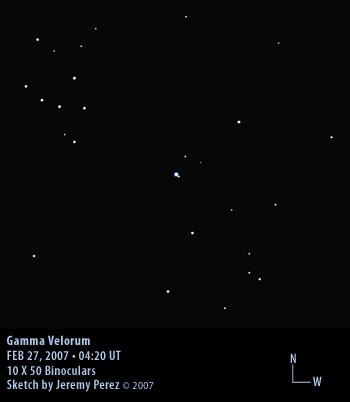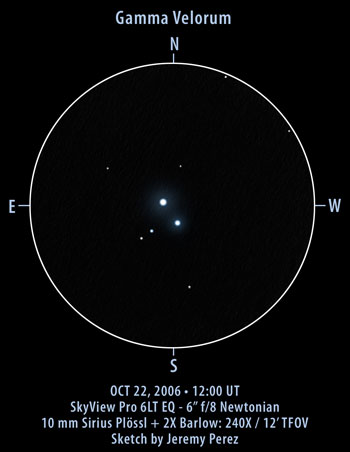Binocular Observation - February 26, 2007:

Click above image for larger version (20K).
I made this binocular observation from my front doorstep with moonlight strongly lighting up the field. The primary of Gamma Velorum was the brightest star in the murky view near the horizon, and gave off a blue light. The secondary snuggled close to the glare of its buddy and at times seemed to appear orange in contrast. I tried for about 15 minutes to pick out the combined light of the third and fourth components, and couldn't convince myself I had seen them.
| Subject | Gamma Velorum (DUN 65) |
| Classification | Multiple Star |
| Position (J2000) | [RA: 08:09:31.9 / Dec: -47:20:11]* |
| Position Angle* | A-B: 220° (1826) A-C: 151° (1835) A-D: 141° (1846) |
| Separation* | A-B: 41.3" (1826) A-C: 62.3" (1835) A-D: 93.5" (1846) |
| Magnitudes* | A = 2.2; B = 4.5; C = 8.5; D = 9.4 |
| Spectral Types* | A = O9+W; B = B3; C = A0; D = A0 |
| Date/Time | FEB 26, 2007 - 09:20 AM MST (FEB 27, 2007 - 04:20 UT) |
| Observing Loc. | Flagstaff, AZ - Home |
| Instrument | 10 x 50 Binoculars |
| Conditions | Clear, breezy, waxing gibbous moon |
| Seeing | - |
| Transparency | NELM ~ Mag 4 |
| References | The Washington Visual Double Star Catalog, 1996.0 (Worley+, 1996), Visual Double Stars in Hipparcos (Dommanget+, 2000) via VizieR, and Burnham's Celestial Handbook. |

Observation Notes:
This is my most southern observation yet. At a declination of -47 degrees, it was about 8 degrees above my southern horizon--add some low hills, and I was only barely able to catch it. As you can imagine, the seeing was horrible, but despite this, Gamma Velorum was a brilliant and worthwhile multiple star to view. Due to the fluttering atmosphere, and strong spreading of the spectrum, estimating color was a bit difficult. Still, I was able to pick out a blue-white color for the primary and bluish coloration to the next two brightest stars.
I estimated the PAs as AB=215°, AC=160°, and AD=150°. Actual values are 220°, 151°, and 141°. I sketched separations as AB=65", AC=80", and AD=106". Those are a bit stretched, with the actual values being 41.3", 62.3", and 93.5". I was surprised not to find a Struve number attached to this one. Rather it was listed as Dunlop 65. I guess I hadn't considered the southern limit for Struve's catalog.
According to Burnham, the primary star of this multiple is actually a spectroscopic binary composed of an O9 blue giant and a Wolf-Rayet giant that orbit with a period of 78.5 days.
| Date/Time | OCT 22, 2006 - 05:00 AM MST (OCT 22, 2006 - 12:00 UT) |
| Observing Loc. | Cinder Hills Overlook, Sunset Crater National Monument, AZ |
| Instrument | Orion SVP 6LT Reflector (150 mm dia./1200 mm F/L) |
| Eyepieces/Mag. | 10 mm + 2X Barlow (240X) |
| Conditions | Clear, calm |
| Seeing | 1-2/10 |
| Transparency | NELM Mag 6.8+ |
*Based on published data.





Hi, I maintain the Space Blogroll, a list of all the space-/astronomy-/rocketry-related blogs that I can find. I added your blog to the blogroll today, the 151st blog added so far. If you would like to add the Space Blogroll to your sidebar, you can find the necessary code for that here. If you don't want to add the space blogroll, that's ok too, you're on the blogroll regardless.
I also run the Space Feeds aggregator, which brings together the 50 most recent space blog posts from over 100 blogs, the 50 most recent news stories from two dozen space news sites, astronomy picture of the day, NASA TV, and loads of space-related links. You might find it a useful tool.